Contents
Exploring Michigan’s Unique Bird Species: Get to Know the Sharp-Tailed Grouse
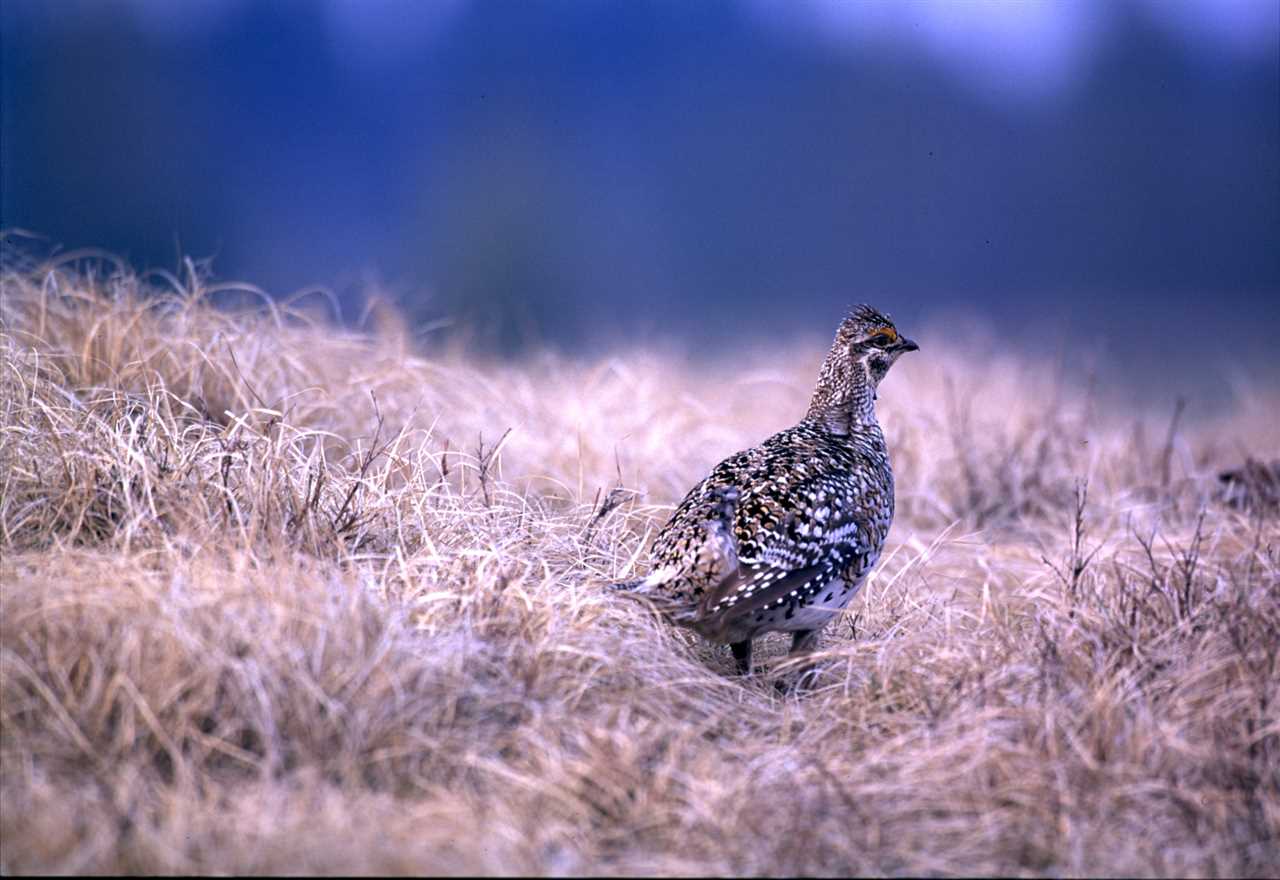
Michigan is home to a diverse range of wildlife, including the fascinating sharp-tailed grouse. This unique bird species, known for its striking appearance and intriguing behaviors, offers bird enthusiasts and nature lovers a wonderful opportunity to explore the natural wonders of the state.
With its distinctive pointed tail feathers and a keen sense of survival, the sharp-tailed grouse is a remarkable creature. Native to Michigan, this bird species thrives in a variety of habitats, from open prairies to dense forests. Its ability to adapt to different environments is truly incredible.
What sets the sharp-tailed grouse apart from other birds is its courtship rituals. During the breeding season, male sharp-tailed grouse gather in communal display grounds, known as leks. Here, they engage in elaborate dances and vocalizations to attract females. Witnessing this impressive display of courtship behavior is a true spectacle.
Exploring the sharp-tailed grouse population in Michigan is not only an opportunity to observe a unique bird species, but also a chance to appreciate the state’s dedication to conservation efforts. Michigan has implemented various conservation measures to protect the sharp-tailed grouse, ensuring that future generations can continue to marvel at the beauty and resilience of this incredible bird.
About Michigan’s Sharp Tailed Grouse
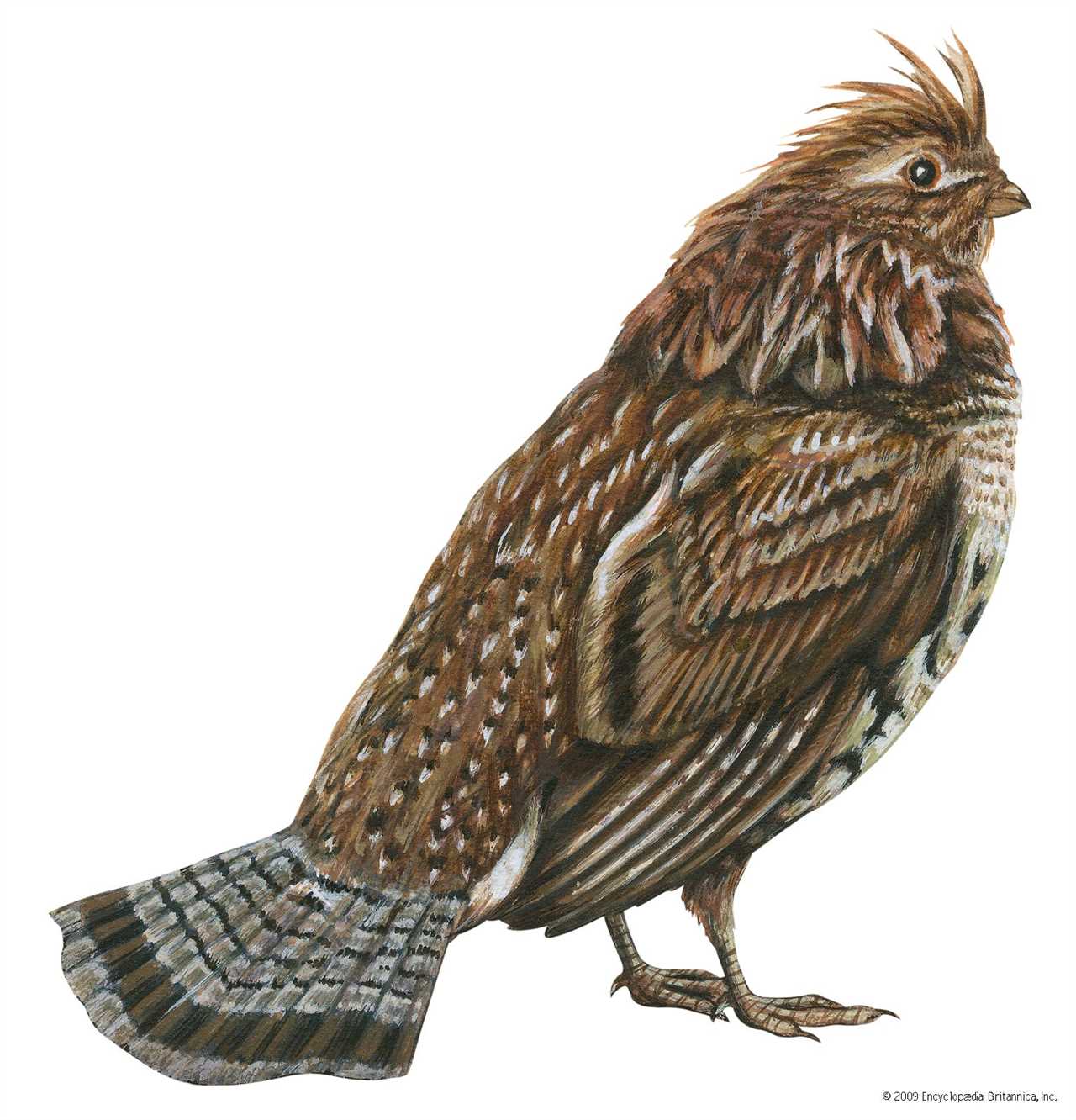
The Sharp Tailed Grouse, scientifically known as Tympanuchus phasianellus, is a unique bird species that can be found in the state of Michigan. This species is a member of the grouse family and is known for its sharp-tailed appearance.
| Common Name: | Sharp Tailed Grouse |
| Scientific Name: | Tympanuchus phasianellus |
| Family: | Grouse |
| Location: | Michigan |
The sharp-tailed grouse is characterized by its distinctive plumage and behavior. It has sharp, pointed tail feathers, which give it its name. The males of this species have white underparts and a mottled brown back, while the females have more muted colors and markings.
These birds are known for their elaborate courtship displays. During mating season, males gather in open areas and perform a unique dance, known as “dancing on lek”. They stomp their feet, raise their tail feathers, and make distinctive popping sounds.
Michigan is a prime habitat for the sharp-tailed grouse, as it offers a variety of suitable habitats, including grasslands, wetlands, and shrublands. These birds prefer areas with a mix of open spaces and cover, where they can feed on a diverse diet of insects, seeds, and fruits.
Despite their unique characteristics and interesting behavior, the sharp-tailed grouse population in Michigan has been declining in recent years. Conservation efforts are underway to preserve the habitat and protect this unique bird species for future generations to enjoy.
The natural habitat

Michigan is home to a diverse range of ecosystems that provide the ideal habitat for the sharp-tailed grouse. These unique bird species can be found in the grasslands and prairies of the state, where they thrive in the open spaces and abundant food sources.
The sharp-tailed grouse are known for their distinctive mating rituals, which take place in specially designated areas called leks. These leks are open clearings within the grasslands, where the males gather to perform elaborate displays to attract females. The females then choose their mates based on these displays, ensuring the survival of the fittest.
The grasslands and prairies of Michigan provide the perfect environment for the sharp-tailed grouse to carry out their unique mating rituals. The tall grasses provide ample cover for the birds to hide from predators, while the open spaces allow for their displays to be seen from a distance.
Additionally, the grasslands and prairies of Michigan offer a bountiful food supply for the sharp-tailed grouse. The birds feed on a variety of plants, including grasses, flowers, and seeds. They also eat insects and small invertebrates, which are abundant in these habitats.
The preservation and protection of these grasslands and prairies are essential for the survival of the sharp-tailed grouse in Michigan. Efforts are being made to conserve these habitats and restore them where they have been lost. By ensuring the health of these ecosystems, we can continue to enjoy the presence of this unique bird species in our state.
| Benefits of the natural habitat for sharp-tailed grouse |
|---|
| Ample cover for hiding from predators |
| Open spaces for performing mating displays |
| Abundant food sources |
| Diverse plant life |
| Opportunities for conservation and restoration efforts |
Physical characteristics

The Sharp-Tailed Grouse is a unique bird species found in Michigan. It is known for its distinctive physical characteristics.
It has a medium-sized body with an average length of around 40 to 50 centimeters. The males are slightly larger than the females. They have a sharp, pointed tail that gives them their name.
Their plumage is primarily brown with mottled patterns in shades of brown and black, which help them blend into their surroundings. The males have a more vibrant coloration and distinct markings on their wings and tail feathers.
Sharp-Tailed Grouse have short necks and small heads. They have round, dark eyes and a small, curved beak designed for foraging on seeds, berries, and insects.
One of the most unique features of this bird is the display of their tail feathers during courtship. The males raise their tail feathers in a fan-like display, exposing the sharp, pointed shape. This display is used to attract females and establish dominance among males.
The average lifespan of a Sharp-Tailed Grouse is around 3 to 4 years in the wild. They are well-adapted to the Michigan climate and can survive in various habitats, including forests, grasslands, and wetlands.
- Medium-sized body with an average length of 40 to 50 centimeters
- Distinctive sharp, pointed tail
- Primarily brown plumage with mottled patterns
- Vibrant coloration and distinct markings on wings and tail feathers in males
- Short necks and small heads
- Round, dark eyes
- Small, curved beak for foraging
Importance of Conservation

Grouse populations in Michigan have been declining in recent years, making conservation efforts crucial for the future of the species. The sharp-tailed grouse is a unique bird species that calls Michigan its home. It is known for its distinctive tail feathers, which provide it with excellent maneuverability and balance during its courtship displays. Unfortunately, habitat loss, predation, and disease have all contributed to the decline in sharp-tailed grouse populations.
Conservation efforts are important to ensure the survival of this bird species and maintain the biodiversity of Michigan’s ecosystems. By protecting and restoring their habitat, such as the grasslands and brushlands that they rely on for food and breeding, we can provide them with the necessary resources to thrive. This includes implementing strategies to reduce the impact of predators and diseases, as well as conducting research to better understand their behavior and population dynamics.
In addition to its ecological importance, the sharp-tailed grouse also has cultural significance for hunters and wildlife enthusiasts in Michigan. Its unique characteristics and behaviors make it a prized species to observe and hunt. By conserving this species, we can ensure that future generations can continue to enjoy the beauty and excitement that this bird brings to Michigan’s natural landscapes.
In conclusion, the conservation of sharp-tailed grouse populations in Michigan is vital for both ecological and cultural reasons. By protecting their habitat and implementing conservation strategies, we can help ensure the survival of this unique bird species and preserve the natural heritage of Michigan for future generations to enjoy.
Threats to the species
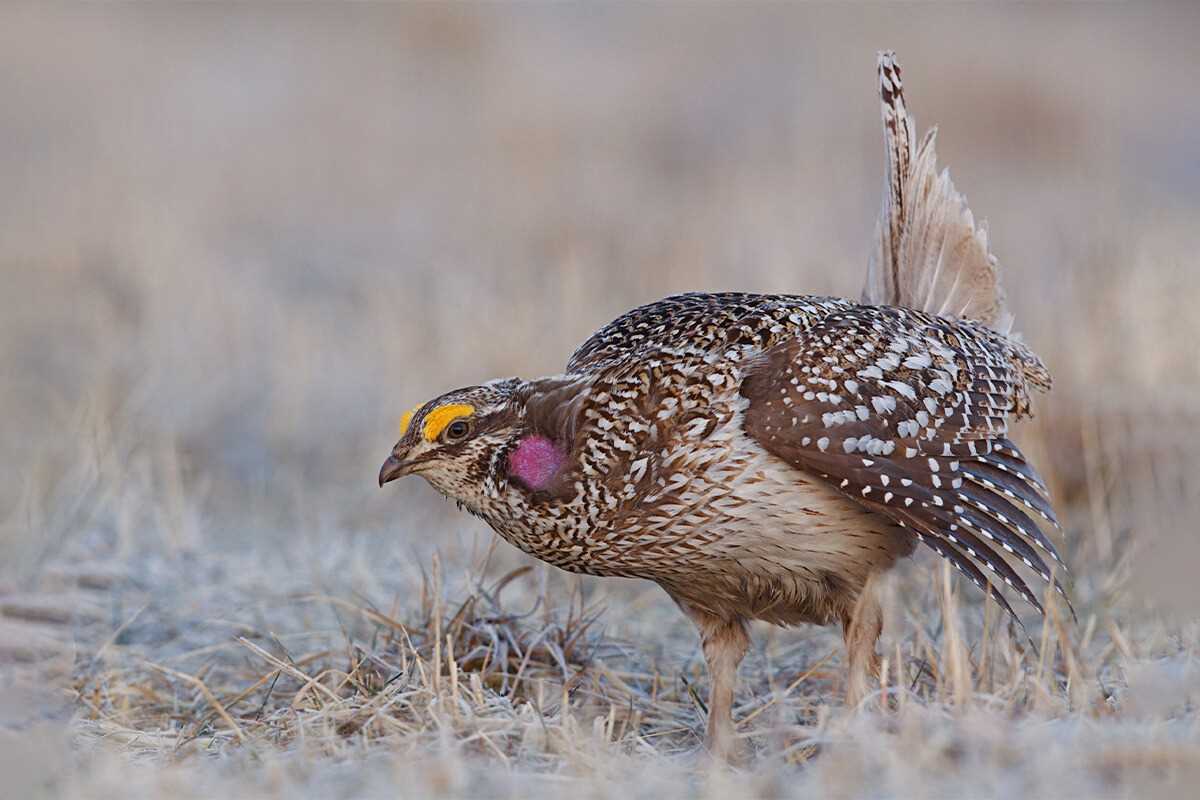
The sharp-tailed grouse population in Michigan faces several significant threats that could impact their survival and overall numbers.
Firstly, habitat loss is a major concern for the sharp-tailed grouse. As development and land use change occurs, their natural habitat is being destroyed or fragmented. These birds thrive in areas of grasslands and shrublands, but with the expansion of agriculture, urbanization, and infrastructure projects, their preferred habitats are diminishing.
Secondly, the introduction of non-native species is a threat to the sharp-tailed grouse population. Invasive species, such as feral cats and foxes, not only compete for resources but also prey on the birds. The presence of these predators can result in reduced nesting success and increased mortality rates.
Additionally, climate change poses a significant risk to the sharp-tailed grouse in Michigan. As temperatures and weather patterns alter, it can disrupt the delicate balance of their ecosystem. Changes in precipitation and temperature can impact vegetation growth, affecting the availability of food and cover for these birds.
Last but not least, hunting and poaching can also have a negative impact on the sharp-tailed grouse population. Although regulated hunting can be sustainable, illegal activities and excessive harvest can result in population declines and disturbance to the species.
Overall, it is essential to address these threats and implement conservation measures to protect the sharp-tailed grouse in Michigan.
Conservation efforts
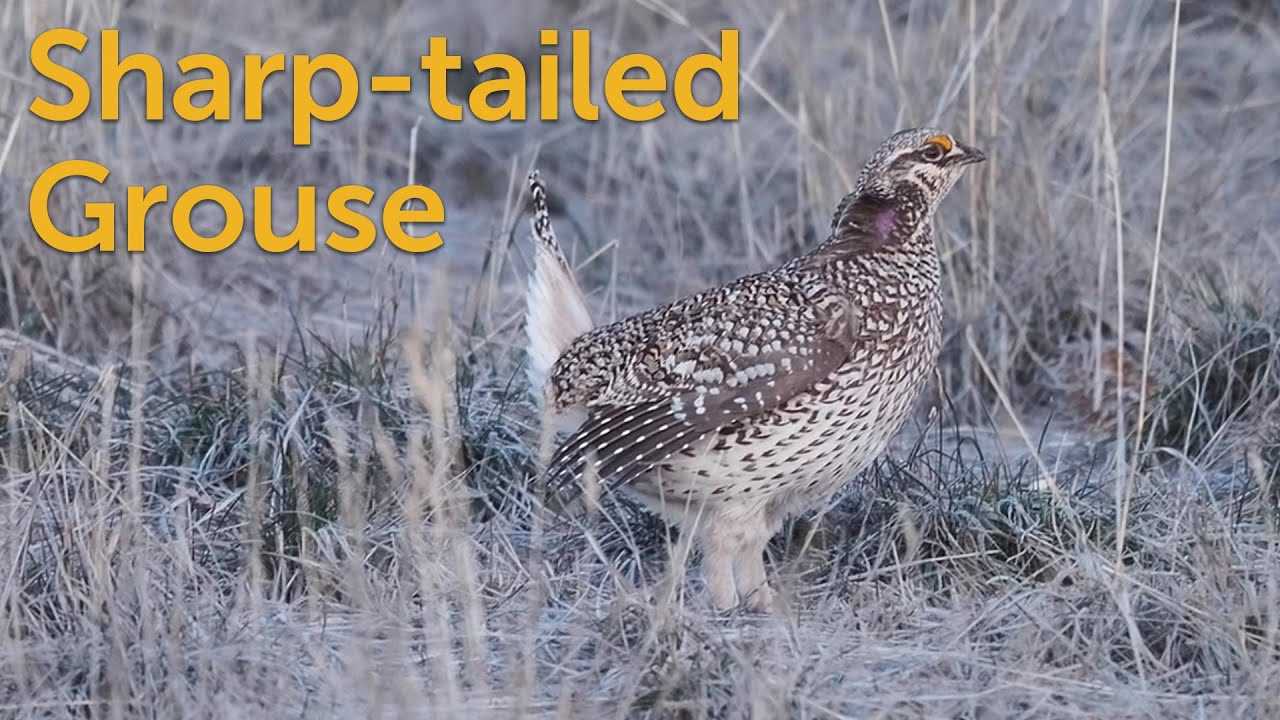
Conservation efforts to protect the sharp-tailed grouse population in Michigan have been ongoing for several years. The Michigan Department of Natural Resources (DNR) has implemented various strategies to ensure the survival and growth of this unique bird species.
One of the main conservation efforts is the preservation and restoration of their natural habitat. The DNR has worked closely with landowners and organizations to identify and protect key areas where the sharp-tailed grouse are known to breed and nest. These areas are carefully managed to maintain the necessary conditions for successful reproduction and population growth.
In addition to habitat preservation, the DNR has also implemented hunting regulations to manage the sharp-tailed grouse population. Limiting the number of birds that can be harvested each year helps to prevent overhunting and maintain a sustainable population. These regulations are continuously evaluated and adjusted based on population surveys and scientific data.
Another important aspect of conservation efforts is public education and awareness. The DNR regularly conducts outreach programs and provides educational materials to help people understand the importance of preserving the sharp-tailed grouse population. By raising awareness, the DNR hopes to encourage individuals and communities to take proactive measures to protect these unique birds.
| Conservation efforts highlights: |
|---|
| Preservation and restoration of natural habitat |
| Implementation of hunting regulations |
| Public education and awareness initiatives |
Behavior and Breeding
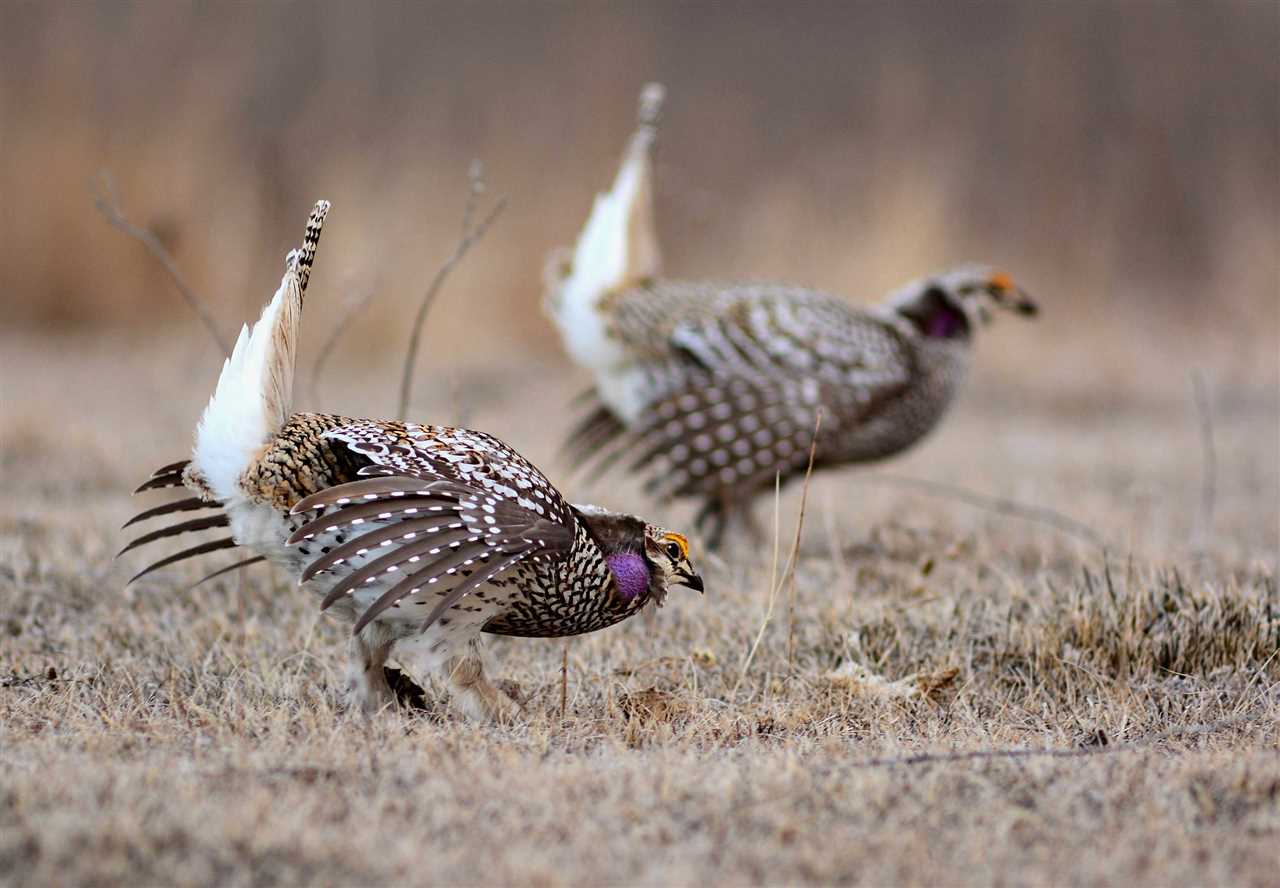
The sharp-tailed grouse is a unique bird species found in Michigan. It is known for its distinctive behavior and intriguing breeding habits.
This species of grouse gets its name from the sharp, pointed feathers on its tail. These feathers are used in courtship displays and are a key characteristic of the male sharp-tailed grouse.
During the breeding season, male sharp-tailed grouse gather in groups called leks. These leks are used as arenas for competition and courtship. The males engage in elaborate displays to attract females, including spreading their tail feathers and making a “drumming” sound by quickly beating their wings against the air.
Female sharp-tailed grouse are highly selective when choosing a mate. They observe the males’ displays and choose the most impressive and dominant male to mate with. Once a female chooses a mate, she lays her eggs in a shallow nest on the ground, usually among grass or shrubs.
The male sharp-tailed grouse does not play a role in raising the offspring. Instead, the female takes on the responsibility of incubating the eggs and caring for the chicks once they hatch. The chicks are precocial, meaning they are born with feathers and are able to move around shortly after hatching.
The behavior and breeding habits of the sharp-tailed grouse make it a fascinating species to study and observe. Its unique courtship displays and selective breeding practices add to the overall beauty and diversity of Michigan’s bird population.
Mating rituals
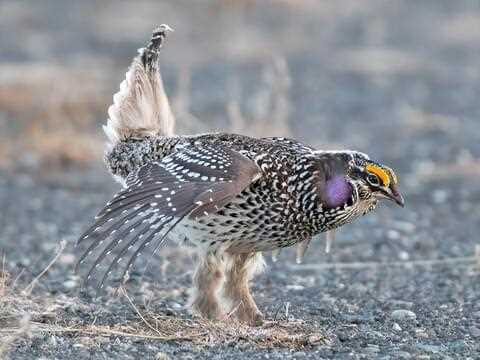
The sharp-tailed grouse, native to Michigan, is known for its elaborate mating rituals.
During the breeding season, male sharp-tailed grouse gather in a designated area known as a lek. They perform a unique courtship display, known as “dancing,” to attract female grouse.
Male grouse stand upright and extend their tail feathers, which are sharply pointed, hence the name “sharp-tailed.” They jump, stomp their feet, and make low booming sounds to make themselves more noticeable to potential mates.
Female grouse observe these displays and choose a mate based on the quality of his performance. The male that displays the most strength, coordination, and stamina is often the one chosen.
This mating ritual is not only a way for sharp-tailed grouse to reproduce, but it also serves as a social gathering for the birds. The lek becomes a meeting place for multiple males and females to interact and select mates.
This unique behavior of the sharp-tailed grouse in Michigan makes it a fascinating bird species to explore and study.
Nesting and parental care
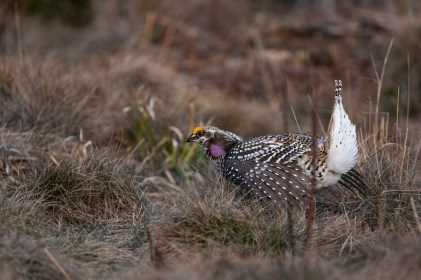
The sharp-tailed grouse is known for its unique nesting habits and exceptional parental care.
The female sharp-tailed grouse typically constructs its nest on the ground, often in dense grass or shrubs. The nest is built by scratching a shallow depression in the soil and lining it with leaves, grass, and feathers. This provides camouflage and protection for the eggs.
The female sharp-tailed grouse lays an average of 10-12 eggs, which have a creamy or pale olive color with dark brown spots. The male sharp-tailed grouse does not contribute to incubation or nest building, but he plays a crucial role in protecting the nesting area.
During incubation, which lasts for approximately 24-25 days, the female sharp-tailed grouse remains on the nest, carefully turning and adjusting the eggs to ensure even heat distribution for proper development. She rarely leaves the nest, relying on her cryptic plumage to blend in with the surroundings and avoid predation.
Once the eggs hatch, the female sharp-tailed grouse leads the chicks away from the nest to begin their life outside. She provides them with protection, guidance, and teaching them important skills such as foraging for food and avoiding predators. The male sharp-tailed grouse may join the female and chicks during this time, forming a family group known as a brood.
The parental care provided by the sharp-tailed grouse ensures the survival and growth of the next generation of this unique bird species. Their dedication and cooperation highlight the remarkable nature of these birds.
Range and Population

The Sharp-Tailed Grouse, also known as the sharptail or the sharpie, is a unique bird species found primarily in the northern regions of Michigan. These birds are known for their distinctive sharp, pointed tail feathers, which give them their name.
The range of the sharp-tailed grouse extends throughout the Upper Peninsula of Michigan, with sightings reported in areas such as the Hiawatha National Forest, the Manistee National Forest, and the Seney National Wildlife Refuge. They are also known to inhabit certain regions of the Lower Peninsula, particularly in areas with suitable mixed forest and grassland habitats.
While once more abundant, the population of sharp-tailed grouse in Michigan has experienced a decline in recent years. Loss of suitable habitat due to land development and changes in land management practices have contributed to this decline. Conservation efforts are underway to protect and restore the habitats of these birds to ensure their future survival and promote population growth.
Despite the challenges they face, the sharp-tailed grouse remains an important species in Michigan’s ecosystem. Observing and learning about these unique birds can provide valuable insights into the health and sustainability of Michigan’s natural landscapes.
Historical Range

The sharp-tailed grouse is a unique and fascinating bird species with a historical range that once spanned across much of Michigan. These birds were commonly found in grasslands, shrublands, and open wooded areas throughout the state.
However, due to habitat loss and changes in land use practices, the sharp-tailed grouse population in Michigan has declined significantly over the years. Today, their range is limited to a few isolated pockets in the northern Lower Peninsula and the Upper Peninsula.
The sharp-tailed grouse’s historical range was more extensive, including areas that are now heavily developed. The loss of suitable habitat, coupled with factors such as predation and competition from other bird species, has contributed to the decline of this unique bird.
Efforts are now being made to restore and preserve the sharp-tailed grouse’s habitat in Michigan. Conservation organizations, working in collaboration with landowners and government agencies, are implementing various strategies to create and maintain suitable habitats for this species.
Understanding the historical range of the sharp-tailed grouse helps us appreciate the significance of its presence in Michigan today. By protecting and restoring their habitat, we can ensure the survival of this unique bird species for future generations to enjoy.
Current population status

The sharp-tailed grouse population in Michigan has experienced a decline in recent years. Once abundant throughout the state, the sharp-tailed grouse is now considered a species of concern. The decline in population is primarily attributed to loss of suitable habitat and changes in land use practices.
Efforts are being made to conserve and restore the sharp-tailed grouse population in Michigan. Conservation organizations, government agencies, and individuals are working together to create and manage suitable habitats, protect known breeding grounds, and promote the conservation of this unique bird species.
Monitoring programs are in place to assess the population status of the sharp-tailed grouse. These programs involve conducting surveys, tracking population trends, and collecting data on habitat conditions to inform conservation and management strategies.
Conservation efforts have shown some promising results, with positive population growth observed in certain areas. However, continued efforts and collaboration among stakeholders are necessary to ensure the long-term survival and recovery of the sharp-tailed grouse population in Michigan.

A skilled hunter, dedicated conservationist, and advocate for ethical practices. Respected in the hunting community, he balances human activity with environmental preservation.
